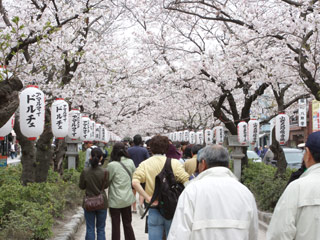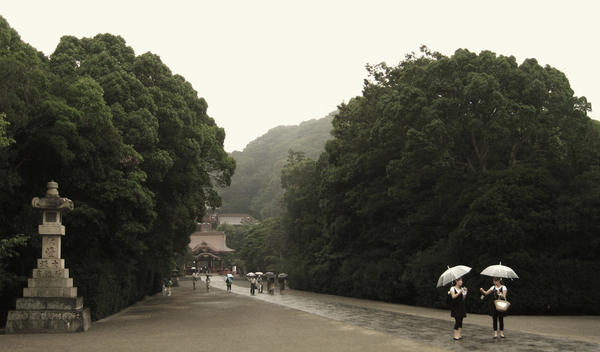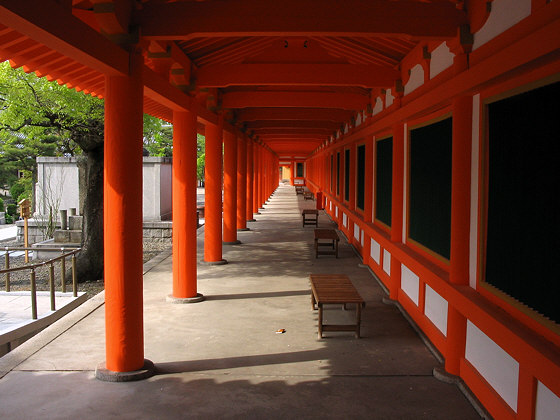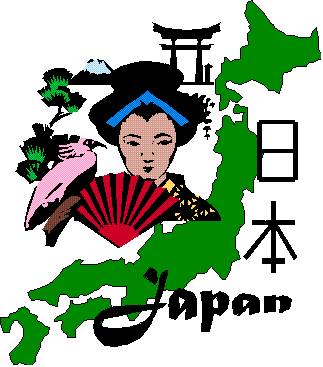First, for comparative purposes, your good, old fashioned, everyday CAUTION sign:
 I think most American's would agree that this is a fairly standard, unextraordinary CAUTION sign. A simple stick figure, a very abstract representation of a human being. It is genderless, faceless, emotionless. Devoid of all context, he trips and falls in a vacuum.
I think most American's would agree that this is a fairly standard, unextraordinary CAUTION sign. A simple stick figure, a very abstract representation of a human being. It is genderless, faceless, emotionless. Devoid of all context, he trips and falls in a vacuum.
The signs I saw in Japan were noticeably different. They seemed to say, "You are not the only person in the world - take care not to forget it". From etiquette signs to warning signs, attention is drawn to the human situation, to the emotions involved. Emotional bystanders are depicted as almost as important, if not as important, as the central figure, who failed to heed the warning. This figure, too, takes on a persona: in the case of coming into some harm, he looks horrified, embarrassed. In the case of being a nuisance, he looks self absorbed or wicked.
I spent a lot of time on subways and trains, staring at advertisements, people watching (as carefully as I could), and trying to puzzle out the Japanese writing on various things. But my eyes kept coming back to these posters, to what they seemed to say about Japanese values.
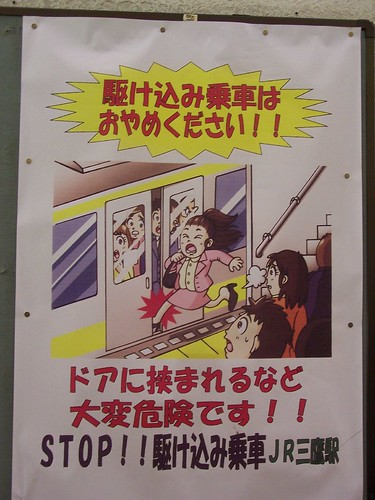 Exhibit One:
Exhibit One:
I didn't take this shot myself. I actually took regrettably few shots of these signs, considering the awkward implications of using flash photography on a crowded train. Still, this serves as an excellent example.
The central figure here is a young woman who, being in a rush, decides to try and dash onto a train that is leaving. Well, this is discouraged for a number of reasons. It may delay the train, and it's not very safe for anyone involved. Predictably, the woman gets her foot stuck. As she screams, those in and outside of the train look horrified, anxious, embarrassed, and a wide range of other negative emotions.
The message: You are not the only person in the world. If you do something stupid, you will get hurt, you will cause a commotion, and you will draw attention to yourself. Are you sure you're in that big of a hurry?
I am not the world's most graceful person. I've lost track of the times that I've missed a step, or slipped, or otherwise embarrassed myself by not being careful enough. Most of these times, I turned bright red when it happened. The pain on the bottoms of my hands or even a skinned knee couldn't compare to my shame at having drawn attention to myself. When people came to ask me whether I was okay, I knew that they meant well, but I wanted to disappear.
 Exhibit Two:
Exhibit Two:Sadly, this is the only one of the three pictures here that I took myself. It was a bad choice, too, as this is the one that popped up most often when I tried to do a Google Search for others I remembered! But it's a classic for a reason.
Uh oh, looks like someone didn't set their phone to manner mode. If the central characters phone was merely ringing, he might merely have been cast as the thoughtless, forgetful half victim. As it is, he is shamelessly, no, wickedly talking loudly into his phone on the crowded train! This goes beyond disregard for others as he seems to be taking pleasure in assaulting their ears. I for one wouldn't want to be sitting next to someone like that, especially with the red lightening bolts coming out of his shoulders!
The message: You are not the only person in the world. Only evil people who hate old women and pretty girls would talk on their phone in the subway. Are you evil?
-------
Exhibit Three:
I saw this sign many times while in Tokyo, but I did take this photograph of it off of Google.
Two women have been out shopping. They simply can't help themselves and start chatting and comparing purchases on the subway, with their things strewn out around them. Although they are very obviously bothering those around them, as evidenced by the huge white eyes of the bystanders, they evidently are living in their own little bubble and don't care.
The message: You are not the only person in the world. Don't take up more space than you're entitled to.
----
Exhibit Four:This exhibit, unfortunately, exists only in my memory and your imagination. If someone has an image of this sign, please let me know! I would love to have it.
The central figure in this image is riding a long distance train. She neglected to sit securely enough - perhaps she wasn't leaning back, perhaps she wasn't wearing a seatbelt. At any rate, when the train stops suddenly, she goes flying forwards.
This being about one week into our trip to Japan, I turned to my friend Laura and said,
"You see? The girl coming out of her seat looks frightened and anxious enough, but also look at the reactions of those around her."
The passengers in the other seats, who had been more careful, looked similar to the bystanders in Exhibit One.
"Even the seat is reacting," said Laura, and I realized it was true. Each seat had been personified with eyes, eyebrows, and a little mouth. They were all looking towards the hapless girl, and they, too, looked horrified, anxious, embarassed.
The message: You are not the only person in the world. Fasten your seatbelt... for everyone's sake.








